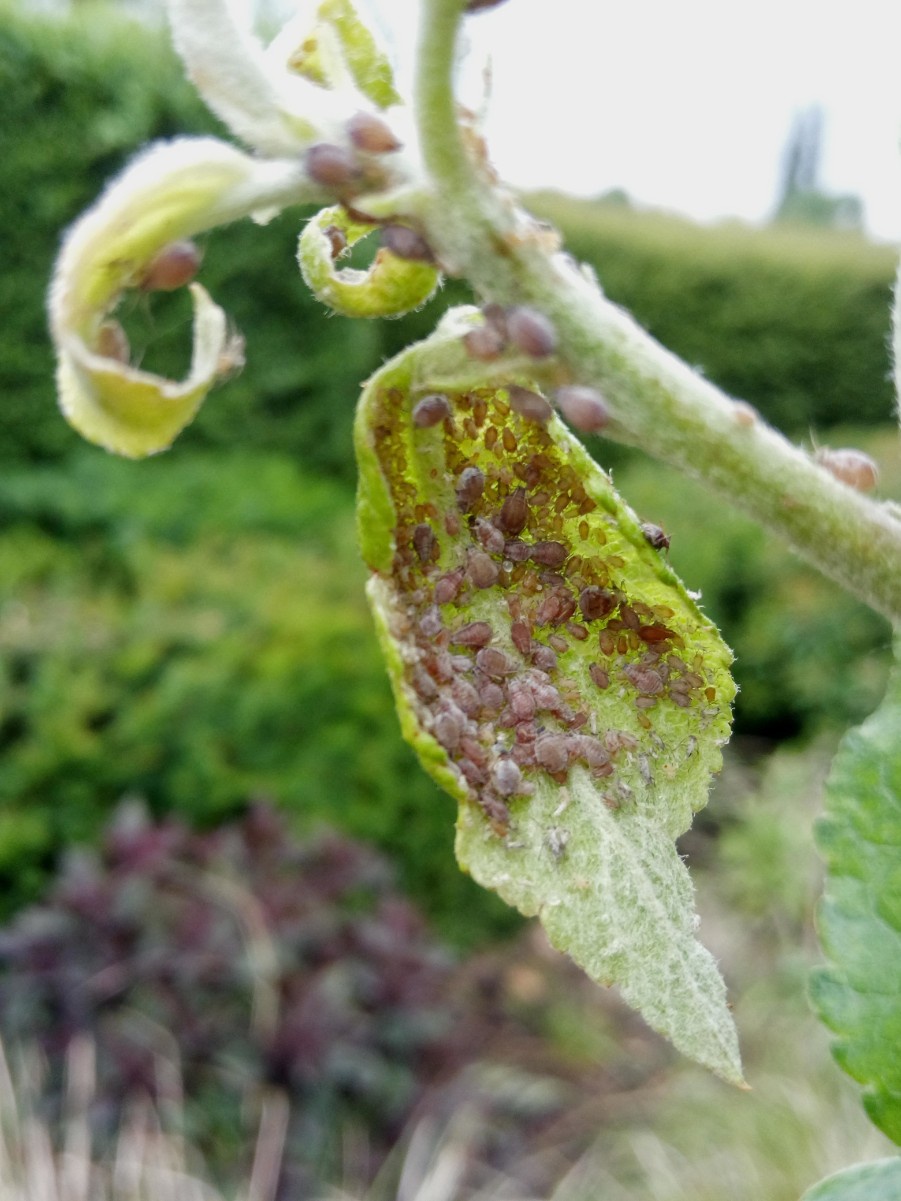Rosy Apple Aphid Threatens Apple Harvest: 10-30% Reduction Predicted

Table of Contents
Understanding the Rosy Apple Aphid (Dysaphis plantaginea)
Identification and Lifecycle
The rosy apple aphid, Dysaphis plantaginea, is easily identifiable by its characteristic pinkish-red color and pear-shaped body. These aphids are typically wingless in their early stages, but winged forms develop later in the season to facilitate dispersal. Their lifecycle begins with overwintering eggs laid on apple tree branches, typically in the crevices of the bark. These eggs hatch in spring, releasing nymphs that begin feeding on new growth.
- Visual Description: Pinkish-red body, pear-shaped, approximately 2mm in length.
- Lifecycle Stages: Egg (overwintering), nymph (multiple instars), adult (wingless and winged forms).
- Host Plant: Primarily apple trees (Malus domestica), although they may infest other plants in the Rosaceae family.
Spread and Infestation
Rosy apple aphids spread primarily through wind dispersal of winged adults. Migrating birds can also contribute to their spread, as can human activity, such as transporting infested plant material. A severe infestation is characterized by several noticeable signs:
- Methods of Spread: Wind, migrating birds, movement of infested plant material.
- Visual Cues of Infestation: Curling and distortion of leaves, stunted growth, presence of large numbers of aphids clustered on leaves and shoots.
- Impact on Tree Health: Weakened plant vigor, reduced fruit production, and potential for secondary infections. Honeydew excretion leads to sooty mold growth, further impacting the tree's health.
The Impact of Rosy Apple Aphid Infestation on Apple Production
Direct Damage to Apples
Rosy apple aphids directly damage apples by feeding on the sap, which weakens the plant and negatively impacts fruit development. This feeding can result in:
- Reduced Fruit Size: Apples may be significantly smaller than normal.
- Misshapen Apples: Fruits can develop irregular shapes and distortions.
- Poor Fruit Quality: Reduced color, blemishes, and overall lower market value.
- Premature Fruit Drop: Infestations can lead to fruit falling from the tree prematurely.
Indirect Damage and Secondary Effects
Beyond the direct damage to the apples, rosy apple aphids excrete honeydew – a sugary substance – which fosters the growth of sooty mold. This black, sooty mold further reduces the marketability of the fruit and impacts the overall health of the apple tree:
- Sooty Mold: Reduces photosynthesis by blocking sunlight, further weakening the tree.
- Impact on Photosynthesis: Reduced sunlight leads to decreased energy production for the tree.
- Reduced Yield: Combination of direct damage and secondary effects leads to significant overall yield reduction.
- Potential for Further Disease Introduction: Sooty mold can provide a breeding ground for other fungal diseases.
Effective Management Strategies for Rosy Apple Aphid Control
Monitoring and Early Detection
Regular orchard inspections are crucial for early detection of rosy apple aphids and prevention of widespread damage. Effective monitoring techniques include:
- Visual Inspection: Thoroughly examine leaves and shoots for the presence of aphids.
- Sticky Traps: Use sticky traps placed throughout the orchard to monitor aphid populations.
- Timing of Inspections: Regular inspections should be conducted throughout the growing season, focusing on periods of new growth and blooming.
Integrated Pest Management (IPM) Approaches
Integrated Pest Management (IPM) utilizes a combination of strategies to control rosy apple aphid populations while minimizing environmental impact. This might include:
- Biological Control: Introducing beneficial insects such as ladybugs (Coccinellidae), lacewings (Chrysopidae), and parasitic wasps that prey on aphids.
- Cultural Control: Pruning to improve air circulation, sanitation practices to remove infested plant debris, and proper orchard hygiene.
- Chemical Control: Using insecticides as a last resort, and only when necessary, selecting products that are safe and effective and that minimize harm to beneficial insects and pollinators. Always follow label instructions carefully.
Predicting and Mitigating Future Rosy Apple Aphid Outbreaks
Climate Change and Aphid Populations
Climate change is expected to influence the lifecycle and population growth of the rosy apple aphid.
- Impact of Warmer Temperatures: Warmer temperatures can accelerate the aphid's life cycle, leading to more generations per year.
- Extended Growing Seasons: Longer growing seasons provide more time for aphid reproduction and spread.
- Increased Rainfall: Certain rainfall patterns can favor aphid development and survival.
Long-term Orchard Management Strategies
Sustainable orchard management practices can reduce the risk of future outbreaks:
- Resistant Apple Varieties: Planting apple varieties with some level of resistance to rosy apple aphids.
- Crop Diversification: Integrating diverse plant species within the orchard to disrupt aphid populations and promote beneficial insects.
- Maintaining Orchard Hygiene: Regularly removing plant debris to eliminate overwintering sites for eggs.
- Promoting Beneficial Insects: Creating a habitat that supports the populations of natural predators of aphids.
Conclusion
The rosy apple aphid poses a serious threat to apple production, with potential yield reductions of 10-30%. Implementing effective monitoring, integrated pest management strategies, and understanding the long-term effects of climate change are crucial for mitigating this threat. By proactively addressing this pest, apple growers can protect their harvests and ensure the continued success of their orchards. Take action now to protect your apple harvest from the devastating effects of the rosy apple aphid. Learn more about effective rosy apple aphid control methods today!

Featured Posts
-
 Bare Beating A Call For Better Public Transport Etiquette
May 19, 2025
Bare Beating A Call For Better Public Transport Etiquette
May 19, 2025 -
 Ufc 313 Controversial Prelims Fight Result Questioned By Fighter Himself
May 19, 2025
Ufc 313 Controversial Prelims Fight Result Questioned By Fighter Himself
May 19, 2025 -
 Eu Austerity And The Rise Of European Emigration
May 19, 2025
Eu Austerity And The Rise Of European Emigration
May 19, 2025 -
 Kristen Stewarts Impact On The Changing Landscape Of Hollywood
May 19, 2025
Kristen Stewarts Impact On The Changing Landscape Of Hollywood
May 19, 2025 -
 Hillsborough County Recognizes De Soto Elementary Principal
May 19, 2025
Hillsborough County Recognizes De Soto Elementary Principal
May 19, 2025
